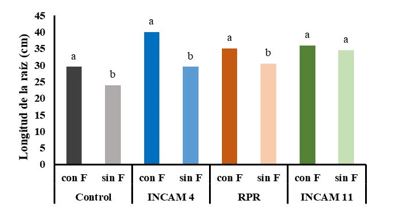Effect of a systemic fungicide on the establishment of Arbuscular Mycorrhizogenic Fungi in maize (Zea mays L.)
Main Article Content
Abstract
Fungicides not only affect the pathogens fungi, but also to others, including those that are beneficial for plant growth, such as arbuscular mycorrhizal fungi. The aim of the present work was to evaluate the effect of a commercial systemic fungicide on the colonization of arbuscular mycorrhizal fungi, inoculated in corn crop, under semi-controlled conditions. Corn plants were inoculated with strains Rhizophagus irregularis INCAM 11, Glomus cubense INCAM 4 and with a conglomerate of different species of arbuscular mycorrhizal fungi, with and without of a systemic fungicide. Colonization frequency and visual density of mycorrhizal fungi were determined at 54 days after inoculation. In addition, the root length, total fresh weight and total dry weight of corn plants were determined. The conglomerate of different species of arbuscular mycorrhizal fungi with fungicide had the highest visual density. The presence of the fungicide increased the root length, total fresh weight and total dry weight of the control plants and those inoculated with Glomus cubense INCAM 4. The effect of strain Rhizophagus irregularis INCAM 11 on the corn growth was not affected for systemic fungicide.
Article Details

This work is licensed under a Creative Commons Attribution-NonCommercial 4.0 International License.
Those authors who have publications with this journal accept the following terms of the License Attribution-NonCommercial 4.0 International (CC BY-NC 4.0):
You are free to:
- Share — copy and redistribute the material in any medium or format
- Adapt — remix, transform, and build upon the material
The licensor cannot revoke these freedoms as long as you follow the license terms.
Under the following terms:
- Attribution — You must give appropriate credit, provide a link to the license, and indicate if changes were made. You may do so in any reasonable manner, but not in any way that suggests the licensor endorses you or your use.
- NonCommercial — You may not use the material for commercial purposes.
- No additional restrictions — You may not apply legal terms or technological measures that legally restrict others from doing anything the license permits.
The journal is not responsible for the opinions and concepts expressed in the works, they are the sole responsibility of the authors. The Editor, with the assistance of the Editorial Committee, reserves the right to suggest or request advisable or necessary modifications. They are accepted to publish original scientific papers, research results of interest that have not been published or sent to another journal for the same purpose.
The mention of trademarks of equipment, instruments or specific materials is for identification purposes, and there is no promotional commitment in relation to them, neither by the authors nor by the publisher.
References
Berruti A, Lumini E, Balestrini R, Bianciotto V. Arbuscular Mycorrhizal Fungi as Natural Biofertilizers: Let’s Benefit from Past Successes. Frontiers in Microbiology [Internet]. 2016 [cited 12/12/2022];6. doi:10.3389/fmicb.2015.01559
Giovannetti M, Avio L, Sbrana C. Functional Significance of Anastomosis in Arbuscular Mycorrhizal Networks. In: Horton TR, editor. Mycorrhizal Networks [Internet]. Dordrecht: Springer Netherlands; 2015 [cited 12/12/2022]. p. 41-67. doi:10.1007/978-94-017-7395-9_2
Bonfante P, Genre A. Mechanisms underlying beneficial plant-fungus interactions in mycorrhizal symbiosis. Nature Communications. 2010;1(1):1-11. doi:10.1038/ncomms 1046
Smith SE, Smith FA. Roles of Arbuscular Mycorrhizas in Plant Nutrition and Growth: New Paradigms from Cellular to Ecosystem Scales. Annual Review of Plant Biology. 2011;62(1):227-50. doi:10.1146/annurev-arplant-042110-1 03846.
Williams A, Manoharan L, Rosenstock NP, Olsson PA, Hedlund K. Long-term agricultural fertilization alters arbuscular mycorrhizal fungal community composition and barley (Hordeum vulgare) mycorrhizal carbon and phosphorus exchange. New Phytologist. 2017;213(2): 874-85. doi:https://doi.org/10.1111/nph.14196
Lenoir I, Fontaine J, Lounès-Hadj Sahraoui A. Arbuscular mycorrhizal fungal responses to abiotic stresses: A review. Phytochemistry. 2016;123:4-15. doi:10.1016/j.phytochem. 2016.01.002
Rivera-Becerril F, van Tuinen D, Chatagnier O, Rouard N, Béguet J, Kuszala C, et al. Impact of a pesticide cocktail (fenhexamid, folpel, deltamethrin) on the abundance of Glomeromycota in two agricultural soils. Science of The Total Environment. 2017;577:84-93. doi:10.1016/j.scito tenv.2016.10.098
Battini F, Cristani C, Giovannetti M, Agnolucci M. Multifunctionality and diversity of culturable bacterial communities strictly associated with spores of the plant beneficial symbiont Rhizophagus intraradices. Microbiological Research. 2016;183:68-79. doi:10.1016/ j.micres.2015.11.012
Fernández F, Rivera R, Noval B. Metodología de recubrimiento de semillas con inoculo micorrizógeno. Patente Cubana. 1999;(22641).
Hernández JA, Pérez JJM, Bosch ID, Castro SN.Clasificación de los suelos de Cuba 2015. Mayabeque, Cuba: Ediciones INCA. 2015;93:91.
Trouvelot A, Kough JL, Gianinazzi-Pearson V. Mesure dutaux de mycorhization VA d’un système radiculaire. Recherche de méthode d’estimation ayant une signification fonctionnelle. In 1986 [cited 12/12/2022]. p. 217-21. Available from: http://pascal-francis.inist.fr/vibad/ index.php?action=getRecordDetail&idt=8758731
Helander M, Saloniemi I, Omacini M, Druille M, SalminenJ-P, Saikkonen K. Glyphosate decreases mycorrhizal colonization and affects plant-soil feedback. Science of The Total Environment. 2018;642:285-91. doi:10.1016/ j.scitotenv.2018.05.377
Espinosa R, Felix F, Martinez L, Cañizares P, Yakelín R,Ortega E. Manejo, integración y beneficios del biofertilizante micorrízico EcoMic (r) en la producción agrícola [Internet]. 2020.
Lekberg Y, Wagner V, Rummel A, McLeod M, RamseyPW. Strong indirect herbicide effects on mycorrhizal associations through plant community shifts and secondary invasions. Ecological Applications. 2017;27(8):2359-68. doi:https://doi.org/10.1002/eap.1613
Cameron JC, Lehman RM, Sexton P, Osborne SL, TaheriWI. Fungicidal Seed Coatings Exert Minor Effects on Arbuscular Mycorrhizal Fungi and Plant Nutrient Content. Agronomy Journal. 2017;109(3):1005-12. doi:https:// doi.org/10.2134/agronj2016.10.0597
Brígido C, van Tuinen D, Brito I, Alho L, Goss MJ, Carvalho M. Management of the biological diversity of AM fungi by combination of host plant succession and integrity of extraradical mycelium. Soil Biology and Biochemistry. 2017;112:237-47. doi:10.1016/j.soilbio.2017.05.018
Schlaeppi K, Bender SF, Mascher F, Russo G, PatrignaniA, Camenzind T, et al. High-resolution community profiling of arbuscular mycorrhizal fungi. New Phytologist. 2016;212(3):780-91. doi:https://doi.org/10.1111/nph.14070
Hage-Ahmed K, Rosner K, Steinkellner S. Arbuscularmycorrhizal fungi and their response to pesticides. Pest Management Science. 2019;75(3):583-90. doi:https:// doi.org/10.1002/ps.5220
Kjøller R, Rosendahl S. Effects of fungicides on arbuscularmycorrhizal fungi: differential responses in alkaline phosphatase activity of external and internal hyphae. Biology and Fertility of Soils. 2000;31(5):361-5. doi:10.1007/s003749900180
O’Connor P, Manjarrez M, Smith SE. The fate and efficacyof benomyl applied to field soils to suppress activity of arbuscular mycorrhizal fungi. Canadian journal of microbiology. 2009;55(7):901-4.
